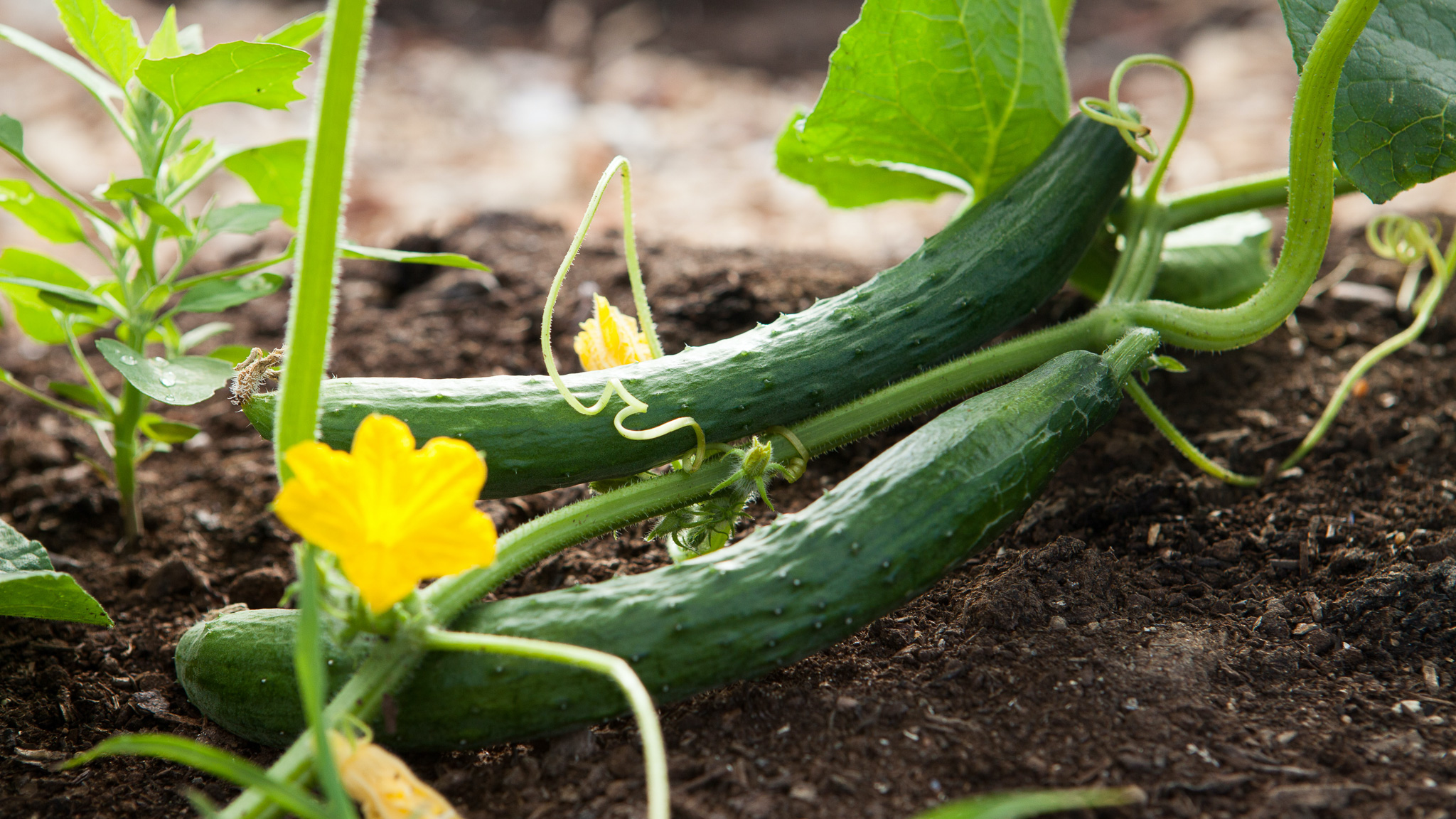The goal of this article is simple: to spare you from my many years of cucumber failures. I started growing cucumbers in a plastic bucket in a windowsill years ago and it ended up being a miserable failure. We got precisely zero food off of multiple plants.
I gave up on the windowsill cucumber plan, moved outdoors, and proceeded to grow lots of unbelievably bitter cucumbers that were totally inedible. As soon as I figured out one problem, I would introduce another one and was disappointed by our cucumbers year after year.
But as a result of all those failures, I’ve learned a good deal about growing cucumbers in containers. In this article, we will cover how you can grow your best-ever cucumber harvest with 9 super-effective tips!
Tip 1: Grow a Gynoecious and Parthenocarpic Variety

While container cucumbers are smaller, have more shallow root systems to draw nutrients from, and generally have fewer pollinators available, there’s a simple solution to these limitations and it’s tip number one. Grow a cucumber variety with the following two characteristics:
- parthenocarpic so that it does not require pollination to set fruit
- gynoecious, which means that the plant produces all (or almost all female flowers) for a 2x larger harvest
For example, the two varieties we’re growing next year, Unagi and Corinto, possess these qualities (and more).
Another big bonus with parthenocarpic varieties is that there is no need to remove the insect netting when your plant starts to flower. So if you know that cucumber beetles are going to be a problem, you can physically protect your plants with a net throughout their entire lifecycle without worrying about poor pollination and fruit set.
Until recently, I defaulted into growing the popular American slicer and pickler varieties like Marketmore 76, Straight 8, and Boston Picklers (you know the ones) and it was such a mistake!
For a bountiful and tasty harvest, it is completely worth your time to track down varieties that are going to make your season more productive. I have a video on understanding cucumber varieties because I genuinely believe it is key to success with these plants.
By the way, if you’d prefer to follow these tips in video format, we’ve got you covered!
Tip 2: Don’t Prune the Suckers
If you do not mind allowing the suckers to trail onto the ground or have 3 feet of horizontal space on your trellis to dedicate for each plant, it is not necessary to trim off the suckers.
That’s tip two, just leave your suckers on.

That may be a controversial statement, but it’s good to keep in mind that pruning suckers off vining plants, cucumbers or otherwise, needs to be part of a broader strategy. Most container cucumber setups are not going to yield a bigger harvest from pruning the suckers. That’s doubly true if you are growing a parthenocarpic variety and don’t have to worry about finding and hand-pollinating the female flowers.
Prune your cucumbers to a single main leader only if you are:
- Planting very densely, meaning about 1 plant every ~12 inches, and training that vine to grow up vertically. We do this for our non-container cucumbers.
- Actively trying to prevent fungal diseases that have proven difficult to manage
However, since container cucumbers are not typically planted densely, most of us can skip the suckering.
Tip 3: Use Extra Peat Moss or Coco Coir & Water Like Crazy
Everyone says that cucumbers are a thirsty plant. I’m here to tell you that they’re 100% right.
But I didn’t always know how to translate that knowledge into practice and ended up not watering my cucumber plants enough. I didn’t want to waste water, you know?
I think part of the disconnect for many gardeners (and maybe I’m projecting what is just a problem for me) is that we grow cucumbers at the same time as our tomatoes. And although applying a more infrequent and conservative watering schedule, as is appropriate for tomatoes, to cucumbers is convenient, it results in unhealthy plants with bitter fruit.
This year, I made a conscious effort to increase the amount of water my cucumbers receive relative to other plants in my garden. Doing so resulted in healthier plants with better fruit quality.
These cucumbers are so thirsty!
For reference, I water our cucumbers very thoroughly twice a day when they’re small and their roots are shallow and once a day when they’re established in summer temperatures between high 90s to low 100s F (over 35 C). That may sound crazy if you’re in a cooler climate but water vanishes fast when it’s that sweltering.
So tip 3 is to allow yourself to water your cukes more.
In addition to increased water, my cucumbers appreciate a higher percentage of water retention ingredients in their potting mix.
I typically use 20 percent sphagnum peat moss or coco coir in my DIY potting mix but with cucumbers I boost that portion right up to one third. They really appreciate it!
Tip 4: Fertilize and Fertilize Often
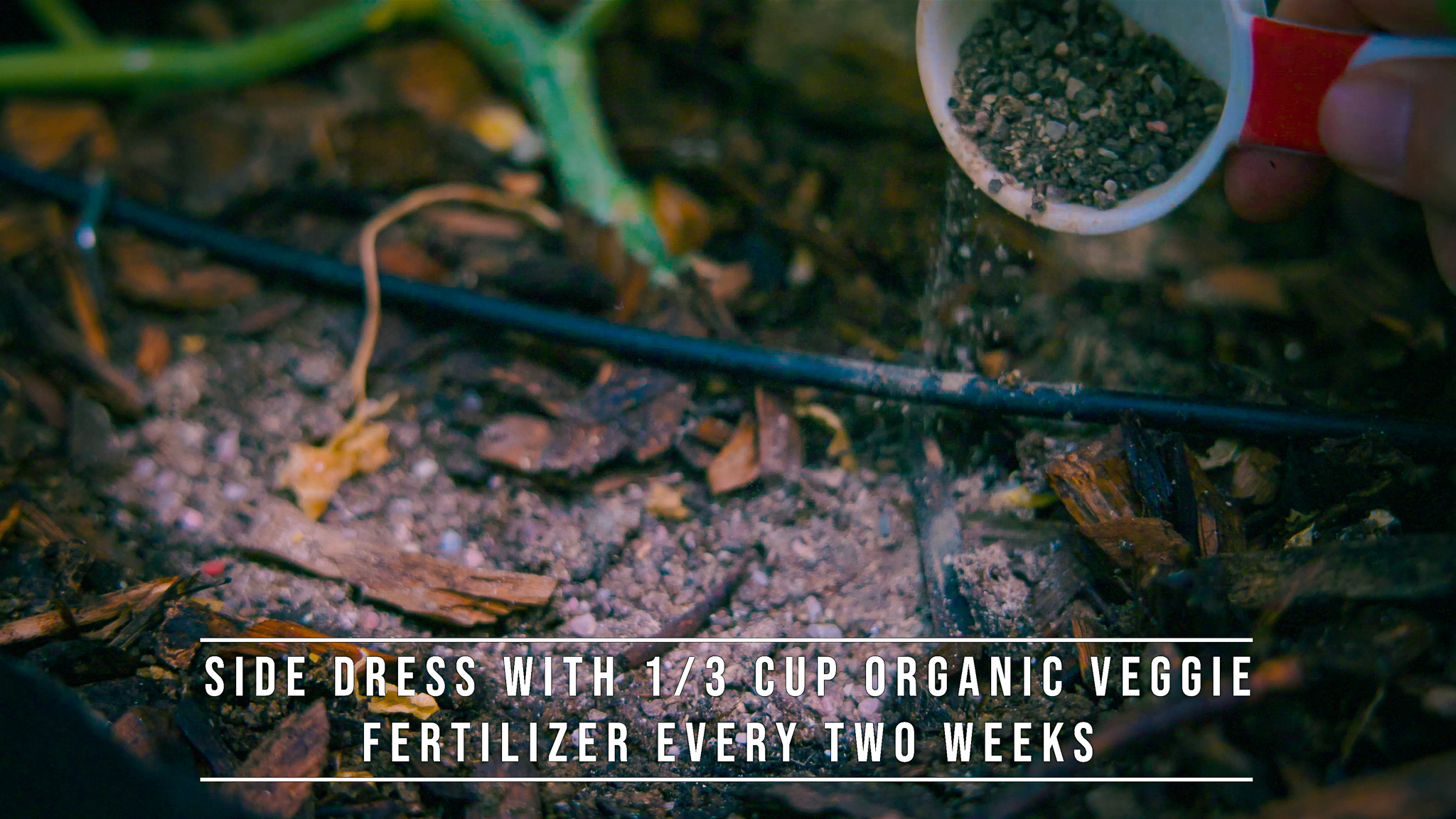
Do cucumbers require less fertilizer than melons and winter squash? Yep. But unfortunately that fact can be misleading… because they still need a whole lot of nutrients.
After much testing with my cucumbers, both in ground and in containers, I found that they do best with generous pre-plant fertilizer and regular side dressings.
So tip number 4 is to fertilize early and frequently.
I also don’t recommend relying on compost alone for nutrients early in the plant’s life cycle. Container cucumber plants do better if I mix in a nice dose of fertilizer right before I transplant them in. I use ½ cup of mild organic vegetable fertilizer, so it’s not a ton but it helps the cukes thrive from the start.
Now, here’s the gotcha: do you remember how much and often cucumbers should be watered? Well, if you plant your cucumbers in heavy clay garden soil, that is not a problem as the negatively charged clay soil particles hold on to the positively charged nutrients like potassium even under heavy watering.
But in containers full of compost and peat moss, watering washes out much more of the soil nutrients. Which is why I fertilize cucumbers every two weeks with ⅓ cup of low nitrogen vegetable fertilizer. In other words, make sure you frequently replenish nutrients even if you can only spare a little.
Also, if you hate the idea of fertilizer drainage from your containers soaking into bare dirt as much as I do, consider planting cover crops or flowers as vegetative buffers all around your containers to minimize your nutrient loss and environmental impact.
Tip 5: Trellis Your Container Cucumbers (It’s Worth It)
Technically, cucumbers do not need to be trellised and will grow contentedly on the ground like a pumpkin. My advice is to do it anyway.
That’s tip five: make an effort to grow your cukes vertically.
A nylon net can support multiple plants, is inexpensive, and especially easy to set up if you have a fence (or other structure) to hold it up.
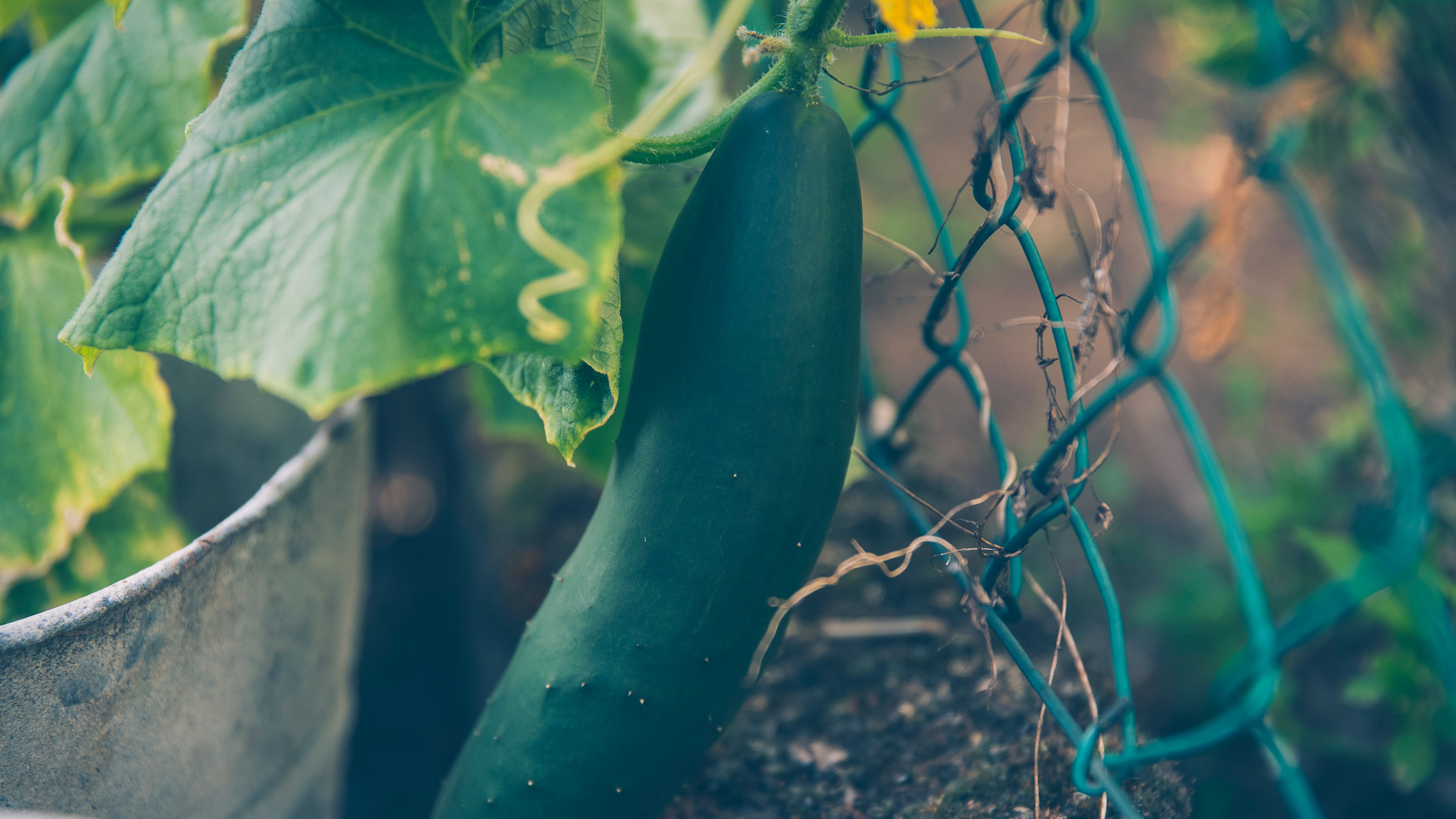
I feel strongly about trellising because a major benefit of a container garden is the separation it provides from some soil-borne diseases and pests.
Take advantage of that benefit by growing the vines up a nice clean trellis. Make the container an advantage!
Tip 6: Don’t Limit Yourself to Small “Bush” Varieties
Bush (AKA determinate) varieties of cucumbers are often marketed as “appropriate for containers”. Which of course implies that indeterminate vining varieties are inappropriate. This is kind of silly.
Focus on selecting productive varieties (see tip #1) as it is not necessary to limit yourself to smaller plants.
A 7-10 gallon grow bag supports a full size vining cucumber and even 5 gallon bags support large plants with frequent enough waterings (or drip line). There is no need for a 30 gallon container (as I recommend for pumpkins) to grow cucumbers successfully.
Tip 7: Transplanting Cucumbers Works Great
Cucumbers are typically sown directly into the ground or container rather than transplanted into the ground as a seedling. Some guides go so far as to say that direct sowing is the only way to plant cucumbers and transplanting will stunt them.
Guess what? I transplant just about everything but root crops, including cucumbers, and it works great!
And sometimes transplanting is the only way to do it. For instance, direct sowing in 105F (40.5C) temperatures outside is a surefire path to disappointment. Few plants want to germinate on the surface of the sun.
It’s also so much easier to care for the small, vulnerable seedlings for a week in a small seedling container or nursery pot than in a 10 gallon container full of dirt and mulch that hasn’t settled yet.
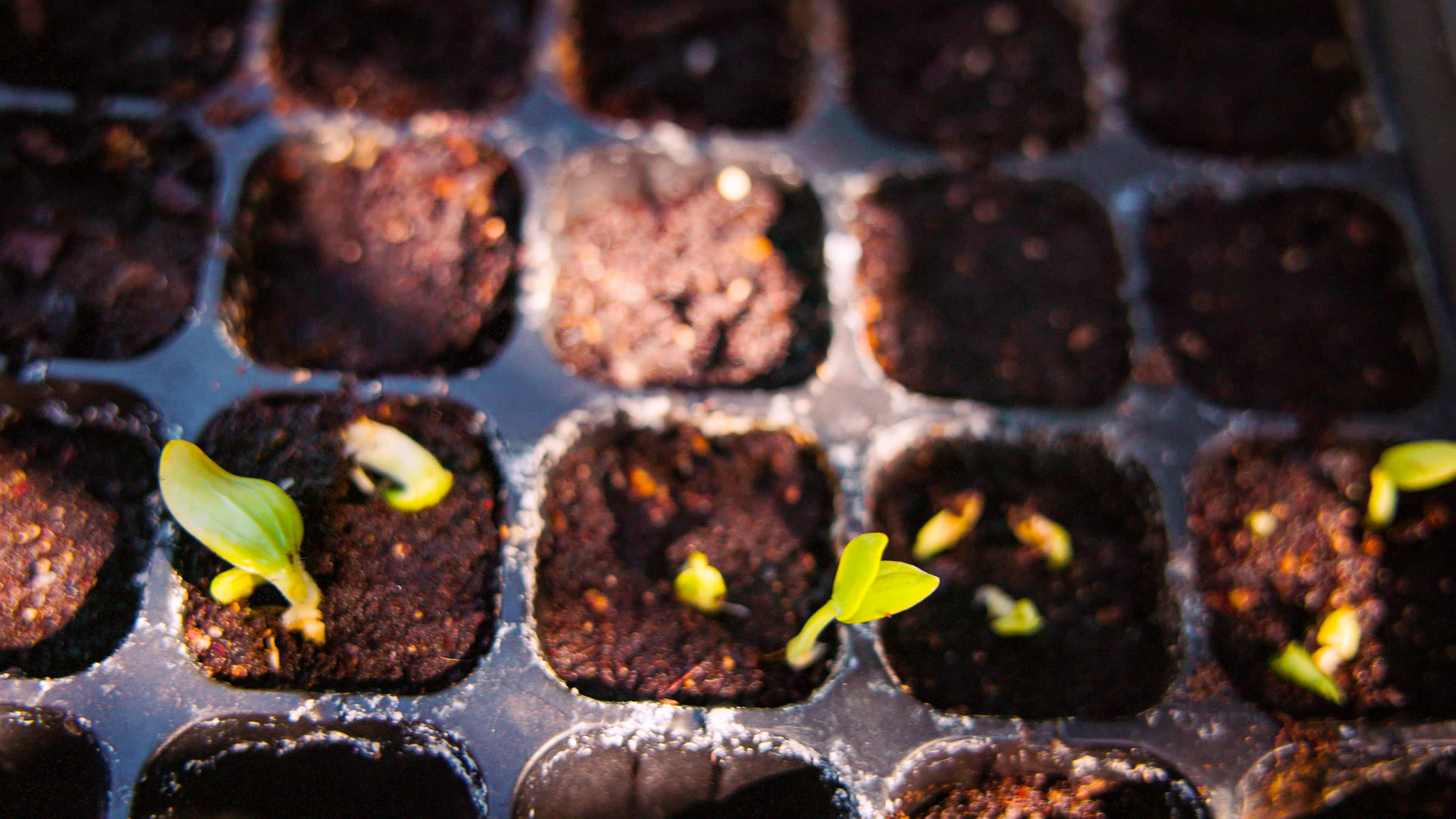
So tip 7 is not to avoid direct sowing (it can work fine too!). It’s don’t hesitate to transplant if direct sowing isn’t a good option for whatever reason.
Tip 8: Do Use Non-Toxic Sticky Traps for Whiteflies
This one is dependent on your environment, but I find that whiteflies absolutely love a healthy cucumber plant. They gravitate to my cucumbers and provide me with endless grief with the physical damage they cause, the disease they spread, and their uncanny ability to attract even more pests.
While dealing with whiteflies could be a separate blog or book of its own, in our garden I put up a couple cheap and nontoxic sticky traps to keep their population down without any work.
I’m all for things that are easy, cheap and effective, even if they’re not perfect. And these traps are not perfect solutions by any means… but they help.
Tip 9: Do Place Containers in Full Sun
This year, I resorted to placing my cucumbers in partial shade because they just seemed like they were frying in the sun. It turns out that was a huge mistake! Even in my hot climate, the cucumber plants grew leggy and stunted from getting only around 6 hours of sun per day.
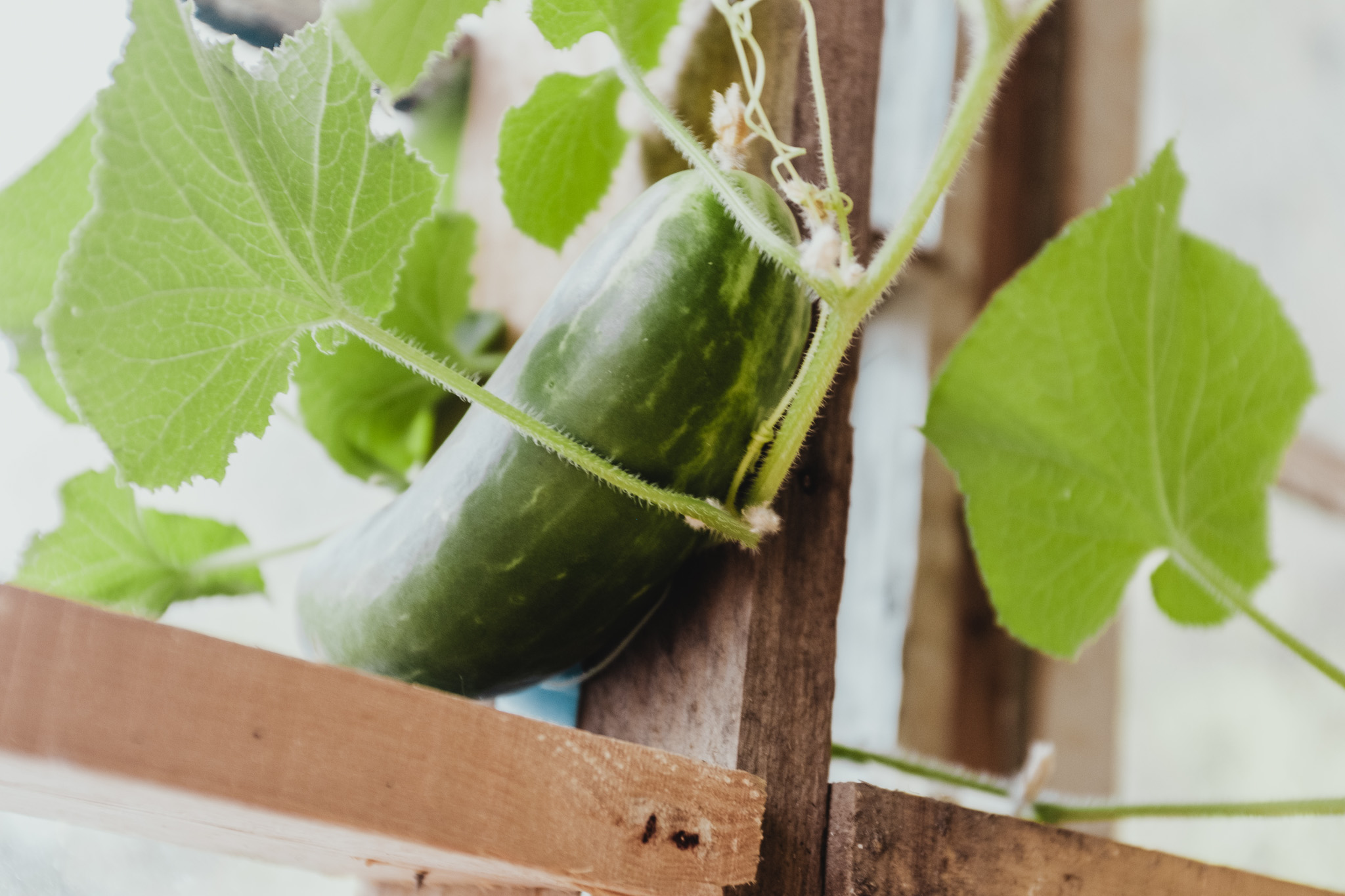
So here are 5 better ways of dealing with heat and sunlight that do not result in leggy plants:
- If you’re somewhere really hot, grow a heat-tolerant variety like Katrina
- Water, water, and water some more. My problem was really one of underwatering
- Don’t over-prune your leaves - those big leaves help keep the stem protected
- Give your plant enough nitrogen to grow big, healthy leaves
- Install some gardeners shade cloth. It is expensive to justify normally, but if all else fails, it works really well
Our cucumber containers are back in full sun so that’s tip number 9 and last one for the day: plant in full sun.
Cucumber Recipe Ideas
And for your enormous harvest, when you are done snacking on them, we have found some truly delicious recipes that showcase our cucumbers. Try these out:
- One of our favorite London trip memories was the high tea served with crumpets and most delicious tea sandwiches, so obviously we had to make them myself using our fresh garden cukes. These cute Cucumber dill tea sandwiches are perfect for a tea date or a snack for you and the kids.
- A refreshing summer favorite of ours is watermelon cucumber salad, which is sweet and minty and savory all at the same time. It’s a quick, easy and healthy side for your meals.
- Caprese cucumber bruschetta brought me back to date nights at Italian restaurants. Bruschetta is just always tasty, as a snack, appetizer or meal, so why not add your cucumber as a refreshing twist?
- For a more traditional use of your cucumbers, these quick refrigerator dill pickles add a nice vinegar saltiness to sandwiches and are a favorite snack in our house.
- Vegan tzatziki sauce tastes amazing with pita wraps or naan or a lot of other meals you might make, try it!
- In our house, we make a lot of smoothies because they are tasty, easy, and most of all because they pack in the veggies to our and the kid’s diet. This cucumber smoothie is so sweet and refreshing that it makes a perfect summer (or year round) dessert, snack or breakfast.
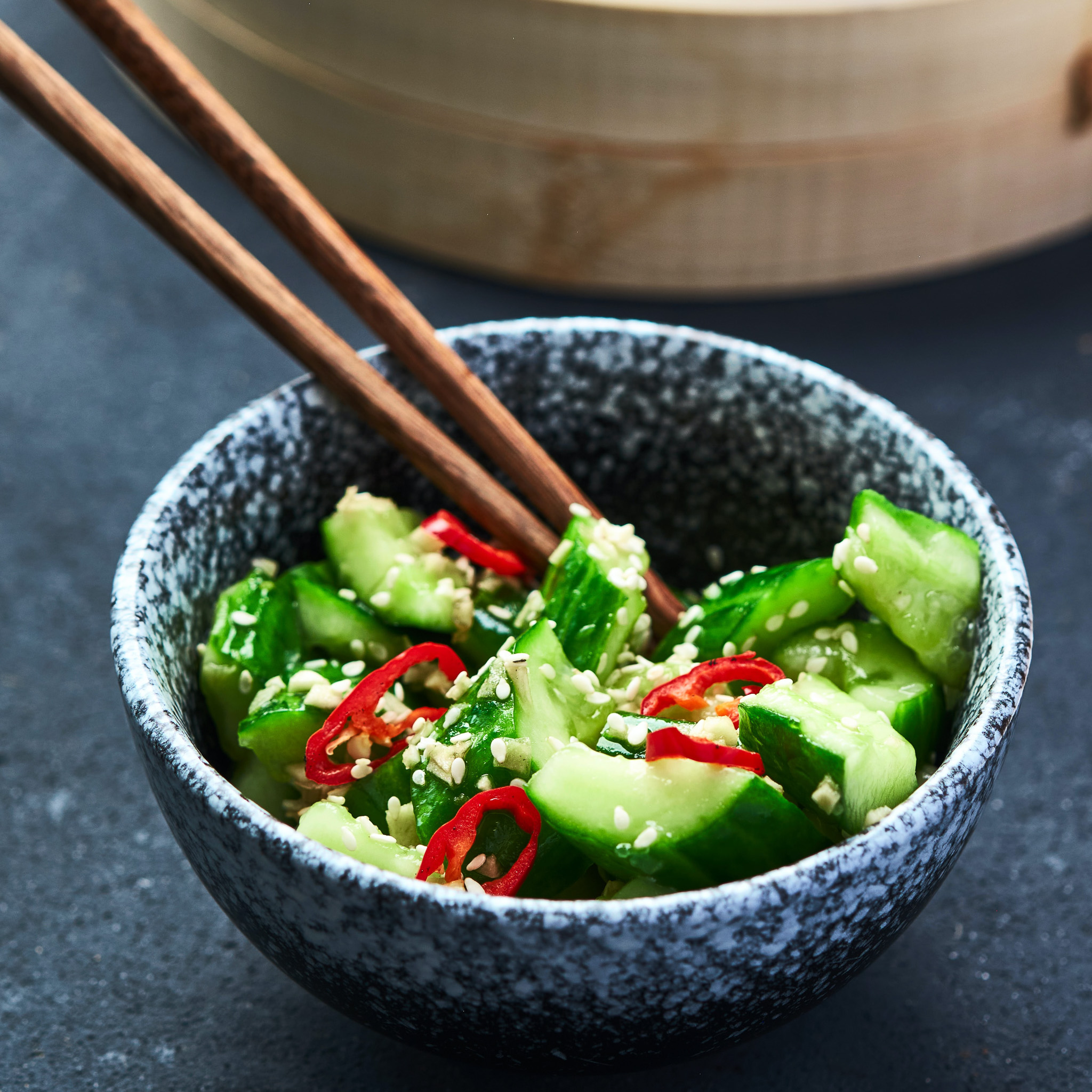
And that’s it. I hope your cucumber season is bountiful and free of bitter, inedible fruits!
